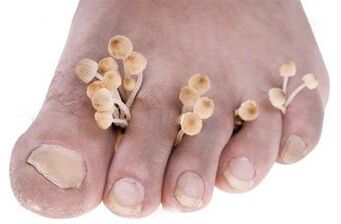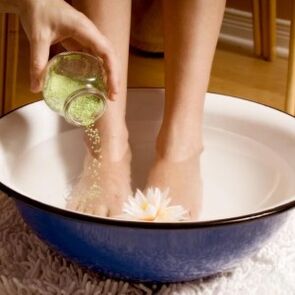
There are many fungi in the world, but only a few of them can infect the human body. Diseases caused by these microorganisms are called mycoses. People call these diseases fungi. The skin of the feet is most often affected. According to medical research, mycosis is the second most common skin disease. The fight against foot fungus should be started as soon as possible. By seeking medical help in time, a person will not only get rid of the problem quickly, but also protect his loved ones from infection.
Signs (symptoms) of athlete's foot
At the early stage of the disease, the patient may not worry about anything. People associate mild discomfort on the skin of their feet with many other reasons and do not rush to seek medical help. The first obvious symptoms appear when the fungus spreads significantly. The patient lives:
- redness of the skin of the legs;
- unpleasant smell from the feet;
- itching and burning;
- skin peeling.
Symptoms of the disease can vary greatly depending on its form. The most common type is intertriginous. Athlete's foot causes the following symptoms:
- burning sensation in legs;
- the appearance of cracks on the skin;
- peeling of the epidermis.
In place of deep cracks, erosive areas can be seen. They bring severe discomfort to the patient, because they cause sharp pain when walking. Subsequently, the skin of the feet becomes very loose, which leads to a significant decrease in local immunity. As a result, secondary infections join the fungal infection, which causes:
- extensive inflammation of the skin of the feet;
- suppuration of affected areas;
- swelling and pain in the legs.
Fungus can also affect the nails. This type of disease is called onychomycosis. Its appearance will be indicated by the color change, thickening or thinning of the plate. If left untreated, the fungus causes damage to all nails or their complete loss.
Causes of the disease
The disease is caused by several types of parasitic fungi. Often, the disease occurs when affected by dermatophytes or red trichophyton. It is possible to determine how to treat foot fungus only after identifying the causative agent. They all do very well and multiply quickly in a humid and warm environment. In this regard, you can get infected when visiting the following public places:

- saunas;
- swimming pool;
- soul;
- baths
Infection can also occur through contact with a sick person or his personal belongings. For example, people who use strangers are at risk of developing athlete's foot:
- towels;
- pumice stones;
- washing clothes;
- socks;
- manicure scissors.
Another factor that affects the rapid spread of the disease is improper foot hygiene. People who wear wet shoes or socks often suffer from fungus. Hypersensitivity to mycoses is observed in those suffering from:
- increased sweating of the feet;
- endocrine diseases;
- decreased immunity;
- diabetes mellitus;
- varicose veins.
Which doctor should I see?
It is very difficult to cope with the disease alone. A patient with such a problem needs the help of a qualified specialist. A dermatovenerologist will tell you how to treat foot fungus.
At the first meeting, specialists will carefully examine the affected areas of the foot. A doctor with extensive experience needs only a visual assessment of the skin to make a diagnosis. But the doctor must also know how the disease appeared. For this, he will have a conversation with the patient. The patient should answer the following questions:

- How long ago did the first symptoms of athlete's foot appear?
- Has this problem bothered you before?
- Do you have chronic diseases?
- Has this person had contact with sick people?
- Have you visited saunas, steam baths or swimming pools?
- Do your relatives have fungal infections of the feet?
Based on the information received from the patient, the doctor can determine the real causes of the disease. To understand how to fight a disease, you need to know exactly what is causing it. Examination helps with this. The patient is prescribed a scrap of skin from the affected area of the leg. After laboratory tests, experts determine the exact cause of the disease.
How to treat the disease?
The sooner a person seeks help, the sooner therapy will be available to him. After receiving the results of the diagnostic examination, the doctor determines how to treat foot fungus. Experts suggest to fight the disease with medicine. The patient is prescribed antifungal drugs:
- stop the development of pathogens;
- destroy fungi;
- has an anti-inflammatory effect;
- eliminate unpleasant symptoms.
Such products are offered in the form of ointments, gels, sprays, tablets or suspensions for oral administration. Special varnishes or plasters for toenail fungus can be used, which have an antifungal effect. The specialist selects drugs for the patient strictly individually, because many of them have a number of contraindications. It is forbidden to take certain medicines:
- pregnant women;
- breastfeeding mothers;
- children.
It is very important to strengthen the immune system to achieve a quick recovery. For this, patients are prescribed vitamin-mineral complexes and immunostimulants. In advanced cases, when secondary infection is associated with fungal infection, patients are prescribed antibiotics.
How to cure toenail fungus forever?
Many patients complain that the disease returns after a while after finishing the course of treatment. This is due to an incompletely treated primary infection. A common mistake many people make is to stop therapy when improvements are seen. It is very important to continue to apply the drug for the entire period prescribed by the doctor. Even if the disease is not visible from the outside, it is not a fact that the entire infection has already been defeated. To prevent re-injury of your feet, you should:
- Strictly follow the recommendations of experts.
- Do not replace drugs with analogues yourself.
- Apply the products regularly, without interruption.
During the treatment, the patient should wear closed slippers at home. You should not allow other family members to wear them, as the infection can be transmitted through them. When treating foot fungus, walking barefoot, sharing clothes, pumice stones or other bath accessories with other people is also prohibited. It is very important during therapy:
- Wash the patient's clothes separately from others.
- Do wet cleaning at home every day.
- Treat the patient's shoes with antifungal agents.
Foot hygiene should also be taken seriously. They should be washed at least 2 times a day. At the same time, they should be treated with hot water. It is important to change your socks often and to wear comfortable, non-tight shoes. After recovery, you must throw away the slippers, towels, clothes, and socks that the person used during the illness.
Prevention
By knowing what causes athlete's foot, you can easily prevent it. To prevent this disease, it is enough to observe the following preventive rules:
- Use only disposable or personal slippers when visiting baths, saunas or swimming pools.
- Do not wear damp or wet shoes.
- If there is a sick person in the house, use only personal bathroom accessories.
Some diseases also increase the risk of fungus. Therefore, by eliminating them in time, the occurrence of the disease can be prevented. Sufferers:
- straight legs;
- corn;
- hyperhidrosis of the feet.
It is important for people to know that the fungus remains for a long time at low temperatures. Therefore, freezing is not scary for him. But the pathogen dies when exposed to high temperature. Therefore, boiling can be used for preventive purposes. If you treat the patient's clothes and shoes in this way, the fungus inside them will die.
























